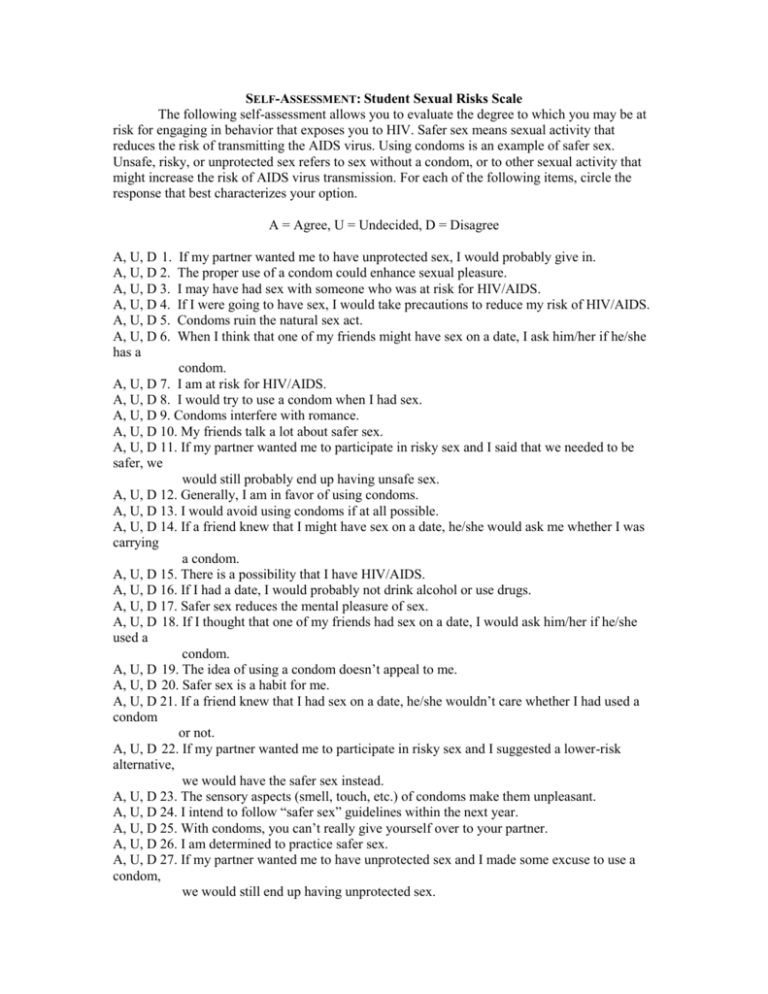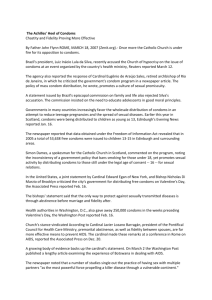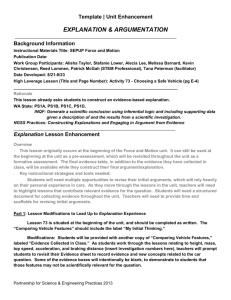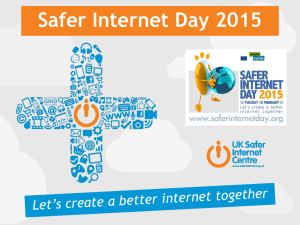
SELF-ASSESSMENT: Student Sexual Risks Scale
The following self-assessment allows you to evaluate the degree to which you may be at
risk for engaging in behavior that exposes you to HIV. Safer sex means sexual activity that
reduces the risk of transmitting the AIDS virus. Using condoms is an example of safer sex.
Unsafe, risky, or unprotected sex refers to sex without a condom, or to other sexual activity that
might increase the risk of AIDS virus transmission. For each of the following items, circle the
response that best characterizes your option.
A = Agree, U = Undecided, D = Disagree
A, U, D 1.
A, U, D 2.
A, U, D 3.
A, U, D 4.
A, U, D 5.
A, U, D 6.
has a
If my partner wanted me to have unprotected sex, I would probably give in.
The proper use of a condom could enhance sexual pleasure.
I may have had sex with someone who was at risk for HIV/AIDS.
If I were going to have sex, I would take precautions to reduce my risk of HIV/AIDS.
Condoms ruin the natural sex act.
When I think that one of my friends might have sex on a date, I ask him/her if he/she
condom.
A, U, D 7. I am at risk for HIV/AIDS.
A, U, D 8. I would try to use a condom when I had sex.
A, U, D 9. Condoms interfere with romance.
A, U, D 10. My friends talk a lot about safer sex.
A, U, D 11. If my partner wanted me to participate in risky sex and I said that we needed to be
safer, we
would still probably end up having unsafe sex.
A, U, D 12. Generally, I am in favor of using condoms.
A, U, D 13. I would avoid using condoms if at all possible.
A, U, D 14. If a friend knew that I might have sex on a date, he/she would ask me whether I was
carrying
a condom.
A, U, D 15. There is a possibility that I have HIV/AIDS.
A, U, D 16. If I had a date, I would probably not drink alcohol or use drugs.
A, U, D 17. Safer sex reduces the mental pleasure of sex.
A, U, D 18. If I thought that one of my friends had sex on a date, I would ask him/her if he/she
used a
condom.
A, U, D 19. The idea of using a condom doesn’t appeal to me.
A, U, D 20. Safer sex is a habit for me.
A, U, D 21. If a friend knew that I had sex on a date, he/she wouldn’t care whether I had used a
condom
or not.
A, U, D 22. If my partner wanted me to participate in risky sex and I suggested a lower-risk
alternative,
we would have the safer sex instead.
A, U, D 23. The sensory aspects (smell, touch, etc.) of condoms make them unpleasant.
A, U, D 24. I intend to follow “safer sex” guidelines within the next year.
A, U, D 25. With condoms, you can’t really give yourself over to your partner.
A, U, D 26. I am determined to practice safer sex.
A, U, D 27. If my partner wanted me to have unprotected sex and I made some excuse to use a
condom,
we would still end up having unprotected sex.
A, U, D 28. If I had sex and I told my friends that I did not use condoms, they would be angry or
disappointed.
A, U, D 29. I think safer sex would get boring fast.
A, U, D 30. My sexual experiences do not put me at risk for HIV/AIDS.
A, U, D 31. Condoms are irritating.
A, U, D 32. My friends and I encourage each other before dates to practice safer sex.
A, U, D 33. When I socialize, I usually drink alcohol or use drugs.
A, U, D 34. If I were going to have sex in the next year, I would use condoms.
A, U, D 35. If a sexual partner didn’t want to use condoms, we would have sex without using
condoms.
A, U, D 36. People can get the same pleasure from safer sex as from unprotected sex.
A, U, D 37. Using condoms interrupts sex play.
A, U, D 38. It is a hassle to use condoms.
Scoring
Begin by giving yourself eighty points. Subtract one point for every undecided response.
Subtract two points every time that you disagreed with odd-numbered items or with item number
38. Subtract two points every time you agreed with even-numbered items 2 through 36.
Interpreting Your Score
Research shows that students who make higher scores on the SSRS are more likely to
engage in risky sexual activities, such as having multiple sex partners and failing to consistently
use condoms during sex. In contrast, students who practice safer sex tend to endorse more
positive attitudes toward safer sex, and tend to have peer networks that encourage safer sexual
practices. These students usually plan on making sexual activity safer, and they feel confident in
their ability to negotiate safer sex even when a dating partner may press for riskier sex. Students
who practice safer sex often refrain from using alcohol or drugs, which may impede negotiation
of safer sex, and often report having engaged in lower-risk activities in the past. How do you
measure up?
(Below 15) Lower Risk
(Of 200 students surveyed by DeHart and Birkimer, 16 percent were in this category.)
Congratulations! Your score on the SSRS indicates that, relative to other students, your thoughts
and behaviors are more supportive of safer sex. Is there any room for improvement in your score?
If so, you may want to examine items for which you lost points and try to build safer sexual
strengths in those areas. You can help protect others from HIV by educating your peers about
making sexual activity safer.
(15 to 37) Average Risk
(Of 200 students surveyed by DeHart and Birkimer, 68 percent were in this category.) Your score
on the SSRS is about average in comparison with those of other college students. Though it is
good that you don’t fall into the higher-risk category, be aware that “average” people can get
HIV, too. In fact, a recent study indicated that the rate of HIV among college students is ten times
that in the general heterosexual population. Thus, you may want to enhance your sexual safety by
figuring out where you lost points and work toward safer sexual strengths in those areas.
(38 and Above) Higher Risk
(Of 200 students surveyed by DeHart and Birkimer, 16 percent were in this category.) Relative to
other students, your score on the SSRS indicates that your thoughts and behaviors are less
supportive of safer sex. Such high scores tend to be associated with greater HIV-risk behavior.
Rather than simply giving in to riskier attitudes and behaviors, you may want to empower
yourself and reduce your risk by critically examining areas for improvement. On which items did
you lose points? Think about how you can strengthen your sexual safety in these areas. Reading
more about safer sex can help, and sometimes colleges and health clinics offer courses or
workshops on safer sex. You can get more information about resources in your area by contacting
the CDC’s HIV/AIDS Information Line at 1-800-342-2437.
Source
DeHart, D. D., and Birkimer, J. C. 1997. The Student Sexual Risks Scale (modification of SRS for popular
use; facilitates student self-administration, scoring, and normative interpretation). Developed specifically
for this text by Dana D. DeHart, College of Social Work at the University of South Carolina; John C.
Birkimer, University of Louisville. Used by permission of Dana DeHart.






